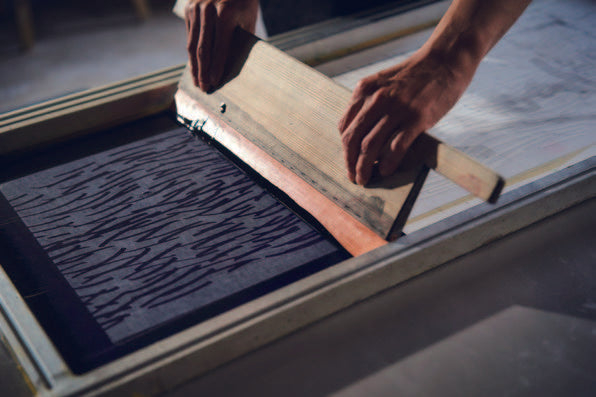
Dyeing, where Color and Time are Layered
Established in 1887 by the skilled dyer Kanbei Nagano in Moto-Aramachi (now Aoba-ku Ichibancho), the Nagakan Dyeing Factory boasts a rich history of crafting happi coats and aprons for the city's merchants, craftsmen, and residents in the past. Today, Nagakan continues to employ traditional methods to create a diverse array of products, ranging from shrine banners and izakaya aprons to noren curtains for the local community.

The Maekake
The maekake is a traditional Japanese apron style that has been worn by craftsmen, restaurant staff, and sake brewery workers since medieval Japan. It serves not only as work attire but also as a unique advertising canvas, displaying the company or shop's signs, name, or founding year. The fabric is sturdy and thick, and the apron is worn by tying the cloth around the hips and letting the front square elegantly drape down to the ankles.

Hikizome
Hikizome, or brush-dyeing, is a technique in which a brush is used to dye entire fabrics. The brush smoothly glides over the surface, ensuring an even application of the dye solution. Shinshi, a kind of bamboo frame, is typically employed during this process to maintain fabric tension.

Select your Pattern and Blend the Colors
Choose your preferred pattern from Nagakan Dyeing Factory's unique designs and mix and match your favorite colors. yourself. You can adjust color tones by modifying the amount of paste mixed, taking into account temperature and humidity to achieve the desired color.

Tenasenzome
Employ the tenasenzome technique to dye the apron's front side. In tenasenzome, a wooden spatula with rubber is carefully used to spread the dye slowly and evenly to ensure that designs are cleanly printed on the fabrics.

Hikizome
Next, you will dye the back side of your apron with a brush in the hikizome technique. Move the brush firmly and quickly from right to left, taking care not to touch the area where the paste has been applied to avoid unevenness. After drying, Nagakan artisans will carry out color fixing, washing, and sewing the apron and tote bag. The items will then be sent to your home later through a mail service by Oshinsha.


